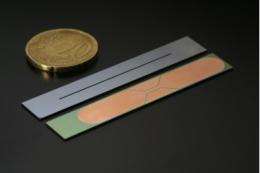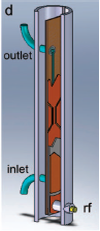NMR on a microscale

(PhysOrg.com) -- The technique well known from its use in MRI scanning - actually based on nuclear magnetic resonance (NMR) - can now also be applied to extremely small samples thanks to an ingenious combination of a compact coil and micro-scale fluidic channels. The sensitivity of this technique had hitherto been insufficient.
With the high-resolution ‘probe’ developed at the University of Twente's MESA+ Institute for Nanotechnology (The Netherlands), it is possible to observe chemical reactions in very close detail, for example. The results have been published in the Journal of the American Chemical Society.
NMR is the technology that is used in MRI scanners in hospitals. This powerful technique uses magnetic fields to create detailed images of human tissue so that abnormalities can be detected and viewed. NMR is also widely used in chemical and biological analysis. However, when an extremely small volume of a substance needs to be analysed, it is difficult to create a ‘coil’ on such a small scale which can generate the required magnetic field. Hitherto, planar circular coils were developed for this use.

These were mounted on a glass chip in which the fluid channels were made. However, diameters of less than 300 microns are difficult to achieve using this technique. The UT researchers therefore opted for the use of ‘stripline’ geometry which enabled a very compact coil to be made in combination with a fluid channel of only 600 nano-litres (one nano-litre is one billionth of a litre). This form means that there are no deviations in the magnetic field, and that selectivity is greater than with conventional flat coils.
The new NMR probe can be used, for example, to follow closely all the intermediate substances that are produced during a rapid chemical reaction. The researchers have also used the new probe to build up an extremely precise picture of the metabolic processes within human spinal fluid. The great advantage of the technique is that the samples do not first have to be pretreated. Ultimately, it will be possible to assemble a complete micro-system to detect and process raw samples.
More information: The article, entitled ‘A microfluidic high-resolution NMR Flow Probe’ and written by Jacob Bart, Ard Kolkman, Anna Jo Oosthoek-de Vries, Kaspar Koch, Pieter Nieuwland, Hans Janssen, Jan van Bentum, Kirsten Ampt, Floris Rutjes, Sybren Wijmenga, Han Gardeniers and Arno Kentgens, was published in the Journal of the American Chemical Society (JACS).
Provided by University of Twente (news : web)
















